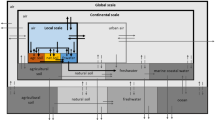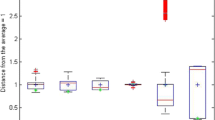Abstract
Purpose
The degradation of chemicals in the environment is often excluded from life cycle assessment (LCA) studies. This paper describes a method to account for greenhouse gas (GHG) emissions from degradation, namely carbon dioxide (CO2), methane (CH4) and nitrous oxide (N2O).
Materials and methods
A multi-media fate model is proposed to estimate the distribution and degradation of chemicals released to the environment. The environmental distribution, along with emission factors and assumptions for each compartment (air, water, soil and sediments), is used to calculate emissions of CO2, CH4 and N2O associated with the initial release of a chemical to either the air, water or soil compartments. These emissions, along with global warming potentials (GWP), are converted to CO2 equivalents from degradation (GWPdeg). The method is described and evaluated with nine organic chemicals.
Results and discussion
Applying the proposed method to the example chemicals shows that all the end products (CO2, CH4 and N2O) have the potential to significantly contribute to GWPdeg, depending on the chemicals’ composition and environmental fate. These emissions, taken to represent the end-of-life stage of these nine chemicals, are shown to be significant when compared with the corresponding cradle-to-gate emissions. For three of the nine chemicals, the degradation emissions in the environment exceeded the cradle to gate phase.
Conclusions
The method enables the accounting of GHG emissions that are currently neglected in many LCA and carbon footprint studies. The model has been parameterized for a generic environmental scenario, but it can be adapted for more site-specific conditions. Uncertainty in this method is associated to the potential lack of chemical-specific data to use in fate modelling, the generic evaluative environment used in fate models and the uncertainty associated with emission factors. A Monte Carlo analysis on the latter shows that the highest uncertainty is expected for chemicals where N2O emissions are the main contributor to GWPdeg.




Similar content being viewed by others
Notes
Recently derived from biomass, i.e. plant or animal sources, as opposed to fossil sources, e.g. peat, coal, oil, etc.
References
AISE and CEFIC (2004) Human & Environmental Risk Assessment on ingredients of European household cleaning products. Substance: Fluorescent Brightener FWA-1 (CAS 16090-02-1), Draft. http://www.heraproject.com/RiskAssessment.cfm?SUBID=23 Accessed 07 Jun 2011
Althaus HJ, Chudacoff M, Hischier R, Jungbluth N, Osses M, Primas A (2007) Life cycle inventories of chemicals. Final report ecoinvent data v2.0 No. 8. Swiss Centre for Life Cycle Inventories, Dübendorf, Switzerland
Audsley E. (Coord) (1997) Harmonisation of environmental life cycle assessment. Final Report Concerted Action AIR3-CT94-2028, European Commission DG VI Agriculture
Baird C, Cann M (2005) Environmental chemistry, 3rd edn. Freeman, New York
BSI (2008) PAS 2050:2008. Specification for the assessment of the life cycle greenhouse gas emissions of goods and services. ISBN 978 0 580 50978 0
Clift R, Brandão M (2008) Carbon storage and timing of emissions. CES Working Paper 02/08. Centre for Environmental Strategy, University of Surrey, Guildford, UK. http://www.surrey.ac.uk/ces/activity/publications/ Accessed 16 Sept 2011)
Dalemo M (1997) The ORWARE simulation model. Anaerobic digestion and sewage plant sub-models. Licenthiate thesis. Swedish Institute of Agricultural Engineering, Swedish University of Agricultural Sciences (SLU), Uppsala. AFR-report 152, Swedish Environmental Protection Agency
De Klein C, Novoa RSA, Ogle S, Smith KA, Rochette P, Wirth TC, McConkey BG, Mosier A, Rypdal K, Walsh M, Williams SA (2006) N2O emissions from managed soils, and CO2 emissions from lime and urea application. In: Eggleston HS, Buendia L, Miwa K, Ngara T, Tanabe K (eds) IPCC guidelines for national greenhouse gas inventories, vol 4. IGES, Hayama, Chapter 11
De Koning A, Schowanek D, Dewaele J, Weisbrod A, Guinée J (2010) Uncertainties in a carbon footprint model for detergents; quantifying the confidence in a comparative result. Int J Life Cycle Assess 15(1):79–89
Doka G (2007) Life cycle inventories of waste treatment services. Final report ecoinvent 2000 No. 13, EMPA St. Gallen, Swiss Centre for Life Cycle Inventories, Duebendorf, Switzerland
Dones R, Bauer C, Bolliger R, Burger B, Faist Emmenegger M, Frischknecht R, Heck T, Jungbluth N, Röder A (2007) Sachbilanzen von Energiesystemen: Grundlagen für den ökologischen Vergleich von Energiesystemen und den Einbezug von Energiesystemen in Ökobilanzen für die Schweiz. Final report ecoinvent data v2.0, No. 6. Swiss Centre for Life Cycle Inventories, Duebendorf, Switzerland
Doorn MRJ, Towprayoon S, Manso Vieira SM, Irving W, Palmer C, Pipatti R, Wang C (2006) Wastewater treatment and discharge. In: Eggleston HS, Buendia L, Miwa K, Ngara T, Tanabe K (eds) IPCC guidelines for national greenhouse gas inventories, vol 5. IGES, Hayama, Chapter 6
European Commission (2010) ILCD handbook. General guide for life cycle Assessment—detailed guidance, 1st edn. European Commission, Joint Research Centre, Institute for Environment and Sustainability, Ispra
Finkbeiner M (2009) Carbon footprinting—opportunities and threats. Int J Life Cycle Assess 14:91–94
Franco A, Fu W, Trapp S (2009) Influence of soil pH on the sorption of ionizable chemicals: modeling advances. Environ Toxicol Chem 28(3):458–464
Gillenwater M, Saarinen K, Ajavon ALN, Smith K (2006) Precursors and indirect emissions. In: Eggleston HS, Buendia L, Miwa K, Ngara T, Tanabe K (eds) IPCC guidelines for national greenhouse gas inventories, vol 1. IGES, Hayama, Chapter 7
Goedkoop M, Spriensma R (2000) The Eco-indicator 99 A damage oriented method for life cycle impact assessment. Methodology Report, 2nd edn. Pré Consultants B.V., Amersfoort
Hauschild M, Wenzel H (1998) Environmental assessment of products. Vol 2: Scientific background, vol. Chapman & Hall, London
Hauschild M, Huijbregts M, Jolliet O, Macleod M, Margni M, van de Meent D, Rosenbaum RK, McKone TE (2008) Building a model based on scientific consensus for life cycle impact assessment of chemicals: the search for harmony and parsimony. Environ Sci Technol 42:7032–7037
Huijbregts MA, Lundi S, McKone TE, van de Meent D (2003) Geographical scenario uncertainty in generic fate and exposure factors of toxic pollutants for life-cycle impact assessment. Chemosphere 51:501–508
Huijbregts MAJ, Struijs J, Goedkoop M, Heijungs R, Hendriks J, van de Meent D (2005) Human population intake fractions and environmental fate factors of toxic pollutants in life cycle impact assessment. Chemosphere 61:1495–1504
i Milà Canals L, Sim S, García-Suárez T, Neuer G, Herstein K, Kerr C, Rigarlsford G, King H (2011) Estimating the greenhouse gas footprint of Knorr. Int J Life Cycle Assess 16:50–58
ISO (2006) ISO 14044: Environmental management—life cycle assessment—requirements and guidelines. ISO, Geneva
Jungbluth N, Chudacoff M, Dauriat A, Dinkel F, Doka G, Faist Emmenegger M, Gnansounou E, Kljun N, Spielmann M, Stettler C, Sutter J (2007) Life cycle inventories of bioenergy. Final report ecoinvent data v2.0 no. 17. Swiss Centre for Life Cycle Inventories, Duebendorf
Keppler F, Hamilton JTG, Braß RT (2006) Methane emissions from terrestrial plants under aerobic conditions. Nat 439:187–191
Lal R, Shukla MK (2004) Principles of soil physics. Marcel Dekker, New York
Le Mer J, Roger P (2001) Production, oxidation, emission and consumption of methane by soils: a review. Eur J Soil Biol 37:25–50
Levasseur A (2011) New Generation Carbon Footprinting thanks to the Dynamic carbon footprinter v1.0. CIRAIG, École Polytechnique de Montréal. http://www.ciraig.org/dynco2_en/ Accessed 24 Feb 2011
Levasseur A, Lesage P, Margni M, Deschenes L, Samson R (2010) Considering time in LCA: dynamic LCA and its application to global warming impact assessments. Environ Sci Technol 44:3169–3174
McKone TE, Enoch KG (2002) CalTOX™, a multimedia total exposure model spreadsheet user’s guide version 4.0 (Beta). Ernest Orlando Lawrence Berkeley National Laboratory, Berkeley
Mohanakumar K (2008) Chemical processes in the stratosphere and troposphere. In: Mohanakumar K (ed) Stratosphere troposphere interactions: an introduction. Springer, New York, pp 209–252, Chapter 5
Muñoz I, i Milà Canals L, Clift R (2008) Consider a spherical man—a simple model to include human excretion in Life Cycle Assessment of food products. J Ind Ecol 12(4):520–538
Nemecek T, Kägi T, Blaser S (2007) Life cycle inventories of agricultural production systems. Final report ecoinvent v2.0 no. 15. Swiss Centre for Life Cycle Inventories, Duebendorf
Nevison C (2000) Review of the IPCC methodology for estimating nitrous oxide emissions associated with agricultural leaching and runoff. Chemosphere Global Chang Sci 2(3–4):493–500
Nielsen PH, Oxenbøll KM, Wenzel H (2007) Cradle-to-gate environmental assessment of enzyme products produced industrially in Denmark by Novozymes A/S. Int J Life Cycle Assess 12(6):432–438
Nisbet RER, Fisher R, Nimmo RH, Bendall DS, Crill PM, Gallego-Sala AV, Hornibrook ERC, López-Juez E, Lowry D, Nisbet PBR, Shuckburgh EF, Sriskantharajah S, Howe CJ, Nisbet EG (2009) Emission of methane from plants. Proc R Soc B 276(1660):1347–1354
Palisade Corporation (2008) @RISK—Risk Analysis Add-in for Microsoft Excel, v. 5.0.1, professional edition. Palisade Corporation, Ithaca
Rosenbaum R, Bachmann TM, Gold LS, Huijbregts MAJ, Jolliet O, Juraske R, Koehler A, Larsen HF, MacLeod M, Margni M, McKone TE, Payet J, Schuhmacher M, van de Meent D, Hauschild MZ (2008) USEtox—the UNEP-SETAC toxicity model: recommended ChFs for human toxicity and freshwater ecotoxicity in life cycle assessment. Int J Life Cycle Assess 13(7):532–546
Rypdal K, Paciornik N, Eggleston S, Goodwin J, Irving W, Penman J, Woodfield M (2006) Introduction to the 2006 guidelines. In: Eggleston HS, Buendia L, Miwa K, Ngara T, Tanabe K (eds) IPCC guidelines for national greenhouse gas inventories, vol 1. IGES, Hayama, Chapter 1
Sonesson U (1997) The ORWARE simulation model. Compost and transport sub-models. Licenthiate thesis. Swedish Institute of Agricultural Engineering, Swedish University of Agricultural Sciences (SLU), Uppsala. AFR-report 151, Swedish Environmental Protection Agency
Sutter J (2007) Life cycle inventories of petrochemical solvents. Final report ecoinvent data v2.0, no. 22. Swiss Centre for Life Cycle Inventories, Duebendorf
USEPA (2009) Estimation Programs Interface Suite™ for Microsoft® Windows, v 4.00. United States Environmental Protection Agency, Washington, DC
Van Hoof G, Schowanek D, Franceschini H, Muñoz I (2011) Ecotoxicity impact assessment of laundry products: a comparison of USEtox and critical dilution volume approaches. Int J Life Cycle Assess 16:803–818
Webster E, Mackay D (2003) Defining uncertainty and variability in environmental fate models. CEMC Report No. 200301. Canadian Environmental Modelling Centre, Trent University, Ontario, Canada. http://www.trentu.ca/academic/aminss/envmodel/CEMC200301.pdf Accessed 09 Jun 2011)
Wegener Sleeswijk A, Heijungs R (2010) GLOBOX: a spatially differentiated global fate, intake and effect model for toxicity assessment in LCA. Sci Total Environ 408:2817–2832
Zah R, Hischier R (2007) Life cycle inventories of detergents. Final report ecoinvent data v2.0, no. 12. Swiss Centre for Life Cycle Inventories, Duebendorf
Acknowledgments
The authors would like to thank Prof. Xavier Domènech (Universitat Autònoma de Barcelona, Spain), M. Phil. Chris Finnegan (Unilever, UK), Dr. Roger van Egmond (Unilever, UK), Dr. Antonio Franco (Unilever, UK) and Denis Kan-King Yu (Unilever, UK), for their valuable comments during the preparation of this work. The comments from three anonymous reviewers helped to significantly improve the clarity of this article.
Author information
Authors and Affiliations
Corresponding author
Additional information
Communicated by Michael Z. Hauschild
Electronic supplementary material
Supplementary material includes a spreadsheet to calculate GWPdeg and a pdf document including a diagram with the generic environment, a literature search on methane oxidation in sediments, a list of parameters used in the equations, chemical-specific data used for the chemicals in the case study, the calculations for these chemicals and a detailed description of the Monte-Carlo Analysis.
ESM 1
(XLSX 31 kb)
ESM 2
(PDF 894 kb)
Rights and permissions
About this article
Cite this article
Muñoz, I., Rigarlsford, G., i Canals, L.M. et al. Accounting for greenhouse gas emissions from the degradation of chemicals in the environment. Int J Life Cycle Assess 18, 252–262 (2013). https://doi.org/10.1007/s11367-012-0453-4
Received:
Accepted:
Published:
Issue Date:
DOI: https://doi.org/10.1007/s11367-012-0453-4




